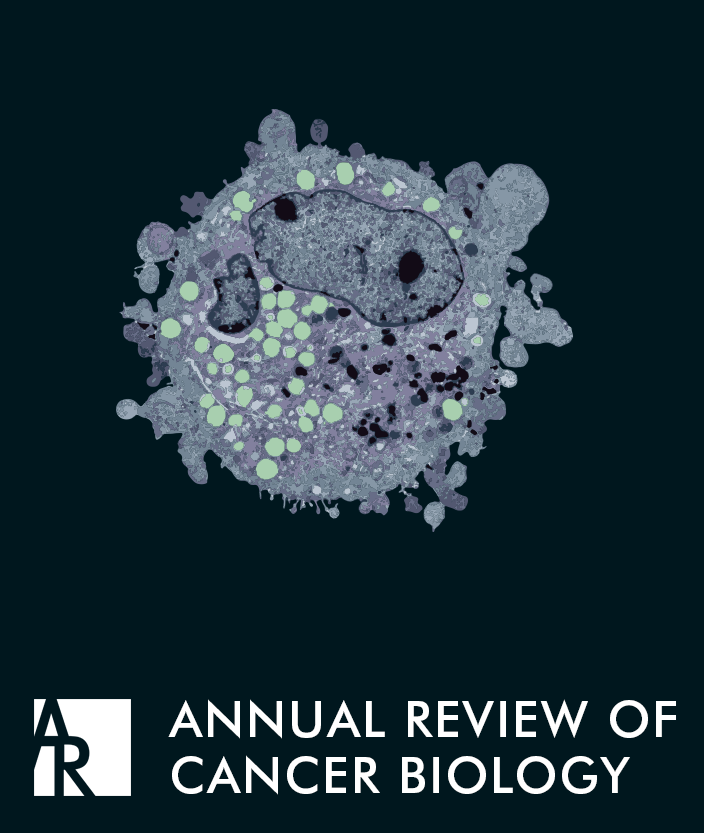癌症微环境中的乳酸和酸性
IF 4.7
2区 医学
Q1 ONCOLOGY
Annual Review of Cancer Biology-Series
Pub Date : 2020-03-09
DOI:10.1146/annurev-cancerbio-030419-033556
引用次数: 58
摘要
发酵性糖酵解是一种古老的进化代谢途径,被快速生长的组织和肿瘤利用,但也发生在对分化组织的营养和能量需求的反应中。它产生的乳酸通过可逆的H+/乳酸同调体(MCT1和MCT4)跨细胞膜运输,并作为糖异生的主要代谢前体和能量来源在器官中循环。利用诱导代谢生物发光成像(imBI)技术研究了肿瘤环境中的乳酸浓度,似乎是肿瘤对照射反应和治疗耐药性的主要生物标志物。在侵袭性肿瘤中,通过乳酸脱氢酶A和B的遗传破坏来抑制乳酸的形成,重新激活OXPHOS(氧化磷酸化),以维持异种移植物肿瘤以一半的速度生长。相反,乳酸转运体MCT1/4的破坏会抑制糖酵解、mTORC1和细胞内酸中毒导致的肿瘤生长。此外,肿瘤酸度的整体降低有助于激活抗肿瘤免疫反应,为未来的临床应用提供了希望。本文章由计算机程序翻译,如有差异,请以英文原文为准。
Lactate and Acidity in the Cancer Microenvironment
Fermentative glycolysis, an ancient evolved metabolic pathway, is exploited by rapidly growing tissues and tumors but also occurs in response to the nutritional and energetic demands of differentiated tissues. The lactic acid it produces is transported across cell membranes through reversible H+/lactate−symporters (MCT1 and MCT4) and is recycled in organs as a major metabolic precursor of gluconeogenesis and an energy source. Concentrations of lactate in the tumor environment, investigated utilizing an induced metabolic bioluminescence imaging (imBI) technique, appear to be dominant biomarkers of tumor response to irradiation and resistance to treatment. Suppression of lactic acid formation by genetic disruption of lactate dehydrogenases A and B in aggressive tumors reactivated OXPHOS (oxidative phosphorylation) to maintain xenograft tumor growth at a halved rate. In contrast, disruption of the lactic acid transporters MCT1/4 suppressed glycolysis, mTORC1, and tumor growth as a result of intracellular acidosis. Furthermore, the global reduction of tumor acidity contributes to activation of the antitumor immune responses, offering hope for future clinical applications.
求助全文
通过发布文献求助,成功后即可免费获取论文全文。
去求助
来源期刊

Annual Review of Cancer Biology-Series
Medicine-Oncology
CiteScore
14.50
自引率
1.30%
发文量
13
期刊介绍:
The Annual Review of Cancer Biology offers comprehensive reviews on various topics within cancer research, covering pivotal and emerging areas in the field. As our understanding of cancer's fundamental mechanisms deepens and more findings transition into targeted clinical treatments, the journal is structured around three main themes: Cancer Cell Biology, Tumorigenesis and Cancer Progression, and Translational Cancer Science. The current volume of this journal has transitioned from gated to open access through Annual Reviews' Subscribe to Open program, ensuring all articles are published under a CC BY license.
 求助内容:
求助内容: 应助结果提醒方式:
应助结果提醒方式:


